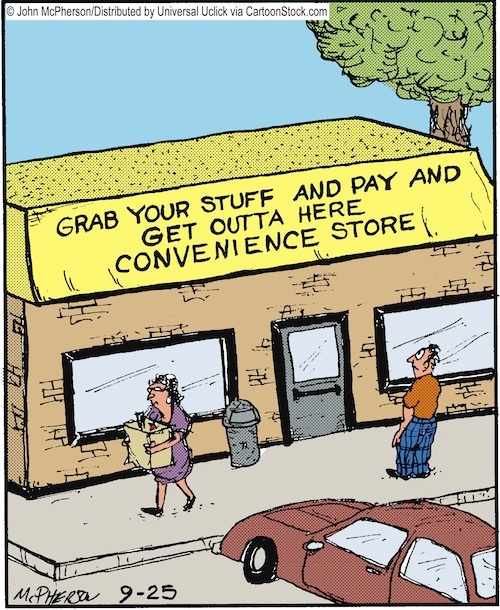In the late 1990s, as a banker in Wilmington, North Carolina, one of my best customers maintained a huge DDA account, borrowed a cool million each year to expand, used treasury services, kept healthy balance sheet, earned solid profits, and had an experienced management team. This customer was a convenience store chain.
Americans love having quick and easy access to the things they need. This may partly explain why there are over 124,000 convenience stores in the U.S., selling a limited selection of merchandise—and also typically gasoline—in high-traffic locations. The average store sells about 128,000 gallons of gas per month and serves about 1,100 customers per day, many of whom live in just a 2- to 6-mile radius of the store’s location.
Most convenience stores are independent operators with over 90 percent of so-called “c-stores” having just one location, though there are numerous chain stores as well. The average convenience store employs around 15 workers, generating about $7-8 million in annual sales of products such as automotive fuel (77 percent of sales), groceries (8 percent), and tobacco products (8 percent). Some c-stores do not sell gas; their sales average $1 million annually and are mainly made up of groceries (50 percent of sales), tobacco products (17 percent), alcoholic beverages (14 percent), and prepared foods and beverages (8 percent).
According to data from Bizminer, the business failure and merger rate for convenience stores from the end of 2015 to the end of 2016 was 5.53 percent, lower than the average U.S. business.
The big-picture numbers
- The convenience store industry consists of 80,900 companies with over 124,000 stores, which generate a total of about $440 billion annually and employ over 985,000 workers.
- While the average c-store chain has about 50 individual stores, most convenience stores are independent operators—over 90 percent of c-stores have a single location and almost 90 percent employ fewer than 10 workers.
- Large companies include Couche-Tard, Casey’s General Stores, 7-Eleven, and Speedway.
- Sales for the convenience store industry are forecast to grow at a 3.52 percent compounded annual rate from 2016 to 2022, slower than the growth of the overall economy.
Top trends and risks within the c-store industry
Vulnerability to economic downswings
During the recession of 2008 and 2009, weakness in the homebuilding sector affected an important customer base for c-stores – construction workers – resulting in a drop in demand for higher margin non-gas items. While the industry has rebounded, they continue to struggle with fluctuating gas prices and credit card interchange fees. Overall, the industry grew 1-2 percent annually from 2011 to 2016, driven by growth in the number of single-store operators. Growth slowed to 0.2 percent in 2017.
Food service evolution
Over the last decade, c-stores have placed increasing emphasis on fresh prepared foods by providing wider selections and better-quality items, such as freshly made sandwiches, pizzas, soups, and salads. Customers short on time continue to demand high-quality, on-the-go meal choices, while c-stores benefit from the higher margins these food products deliver.
Coffee rush
Many operators are upgrading coffee stations and offering gourmet and specialty brews to better compete with higher-end coffee houses. Adopting single-cup brewing technology allows c-stores to offer custom, fresh brews and minimize waste. During recessionary times, c-stores offer a perfect alternative for customers looking for a fast cup of coffee at a good value.
More demand for alternative fuels
Growing concern over the environment and dependence on fossil fuels has generated increased interest and demand for alternative fuels, such as E-85 (ethanol blends), compressed natural gas, biofuels, hydrogen, and electrical technologies. In some regions of the country, E-85 offers higher margins than traditional fuel products, and the push to install more E-85 pumps is often supported with government grants and incentives.
More specialized services
A growing number of c-stores are offering non-traditional services, including banking, dry cleaning, and medical care, to generate incremental store traffic and revenue. Special services can attract new customers and create additional profit centers with strong margins. The additional traffic also helps drive fuel and merchandise sales.
Tobacco product shift
Convenience stores are allotting a larger portion of shelf space to non-traditional tobacco and nicotine products like smokeless e-cigarettes and nicotine alternatives. Convenience stores also benefit from gross profits that are about 25 percent higher on e-cigarettes than traditional cigarettes.
Social media and apps
Convenience stores are increasingly using social media and mobile applications to drive traffic and sales. On social media sites such as Facebook, convenience stores can inform customers of promotions and events, obtain feedback, and feature contests. Mobile apps typically include a store locator, fuel prices, and coupons.
How bankers can help drive c-store business
- Managing cash and credit/debit card payments (73 percent of purchases are made with plastic).
Solutions to consider: Merchant services, remote cash deposit
- Managing fluctuations in costs for low-margin fuel sales (77 percent of industry revenue).
Solutions to consider: Line of credit
- High start-up costs and upgrades to meet government standards (typical store start-up investment is $2 million).
Solutions to consider: Term loans, line of credit - Reducing costs associated with high employee turnover.
Solutions to consider: Employee payroll card
- Efficiently paying suppliers given high inventory turnover (inventory turns every 22 to 25 days).
Solutions to consider: ACH services with blocks and filters
One of my fondest memories from being a banker was conversations with my convenience store company’s CFO about their growth plans and their business. The knowledge from those conversations helped me land another convenience store chain as a customer…I had a niche!
If convenience store lending meets your bank’s credit goals, might you consider going after this niche as well?
Want this kind of in-depth analysis on more than 300 other industries?
All of the industry information in this post came directly from the Vertical IQ Industry Profile on Convenience Stores. Reviewing this profile, or even doing a quick five-minute review of the industry’s Call Prep Sheet, gives you valuable insights into your c-store banking prospect–their opportunities as well as the issues that may be keeping them up at night.
Ready to get started? Contact us today for more information or a demo!




